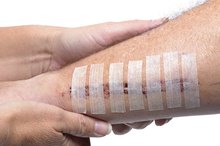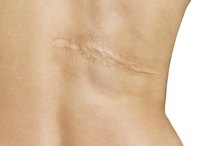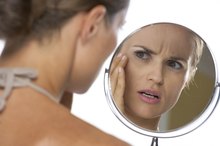4 Ways to Treat Scars and Dark Spots on Your Skin
Whether the cause is cystic acne, a burn or a cut, scarring is the method your body uses to heal a wound. While most scars and dark spots will fade over time, a deep cut may result in a pretty big scar.
If you feel there may be something abnormal or extreme about your scarring, consult a dermatologist before you explore at-home care or other treatments.
Read more: 5 Foods to Make You Look Younger and 5 That Age You
What Are Scars and Dark Spots?
Scars occur and heal in a similar way no matter their cause, according to the American Academy of Dermatology (AAD) 2. When the skin gets injured, your body works to repair the damage. The depth of the injury determines whether or not you're left with a scar or a darker-than-normal spot in the aftermath.
When a lesion goes deeper than the first layer of skin, your body will form thicker tissue, which ultimately becomes a scar, according to the AAD. The depth of the cut (or pimple, in some cases) also determines how high the scar rises above your skin.
Read more: The Best Anti-Aging Tips Regardless of Your Age
- Scars occur and heal in a similar way no matter their cause, according to the American Academy of Dermatology.
- When a lesion goes deeper than the first layer of skin, your body will form thicker tissue, which ultimately becomes a scar, according to the AAD.
How To Treat Scarring or Dark Spots
A Healing Scar Turned Blue
Learn More
There's usually no medical reason to treat a scar or a dark spot, and plenty of people with scarring embrace the skin they're in. That said, if you choose to seek treatment, there are several routes you can pursue to minimize the appearance of scars or dark spots.
A good place to start is with home skin care, according to the Mayo Clinic 1. Many over-the-counter products can improve the appearance of mild scarring and darkening. If your skin concerns are more severe, however, your dermatologist can prescribe other topical options.
Soft tissue fillers are another commonly used option, according to the Mayo Clinic. This procedure involves an injection of collagen or fat under the skin in order to fill out indented scars, ultimately making them less noticeable. However, the results of this treatment don't last forever and the procedure needs to be repeated.
Your dermatologist may also recommend a chemical peel, which involves applying a high-potency acid to the skin, causing the top layer to shed (like a sunburn). Typically, several peels are necessary in order for scars or dark spots to be completely eliminated.
Laser resurfacing is another procedure that you may want to consider, according to the Mayo Clinic. This is another treatment that your derm may suggest and involves using a laser to improve the appearance of the skin.
- There's usually no medical reason to treat a scar or a dark spot, and plenty of people with scarring embrace the skin they're in.
- Your dermatologist may also recommend a chemical peel, which involves applying a high-potency acid to the skin, causing the top layer to shed (like a sunburn).
Related Articles
References
- MayoClinic.com: "Acne scars: What's the best treatment?"
- American Academy of Dermatology Association: "Scars"
- Saint-jean M, Khammari A, Jasson F, Nguyen JM, Dréno B. Different cutaneous innate immunity profiles in acne patients with and without atrophic scars. Eur J Dermatol. 2016;26(1):68-74. doi:10.1684/ejd.2015.2713
- Archer CB, Cohen SN, Baron SE. Guidance on the diagnosis and clinical management of acne. Clin Exp Dermatol. 2012;37 Suppl 1:1-6. doi:10.1111/j.1365-2230.2012.04335.x
- Woolery-lloyd H, Kammer JN. Treatment of hyperpigmentation. Semin Cutan Med Surg. 2011;30(3):171-5. doi:10.1016/j.sder.2011.06.004
- Hedelund L, Haak CS, Togsverd-bo K, Bogh MK, Bjerring P, Haedersdal M. Fractional CO2 laser resurfacing for atrophic acne scars: a randomized controlled trial with blinded response evaluation. Lasers Surg Med. 2012;44(6):447-52. doi:10.1002/lsm.22048
- Hedelund L, Moreau KE, Beyer DM, Nymann P, Haedersdal M. Fractional nonablative 1,540-nm laser resurfacing of atrophic acne scars. A randomized controlled trial with blinded response evaluation. Lasers Med Sci. 2010;25(5):749-54. doi:10.1007/s10103-010-0801-1
- Kim EK, Hovsepian RV, Mathew P, Paul MD. Dermabrasion. Clin Plast Surg. 2011;38(3):391-5, v-vi. doi:10.1016/j.cps.2011.05.001
- Wollina U, Goldman A. Fillers for the improvement in acne scars. Clin Cosmet Investig Dermatol. 2015;8:493-9. doi:10.2147/CCID.S86478
- Fabbrocini G, Annunziata MC, D'arco V, et al. Acne scars: pathogenesis, classification and treatment. Dermatol Res Pract. 2010;2010:893080. doi:10.1155/2010/893080
- Alexiades M. "Laser and Light-Based Treatments of Acne and Acne Scarring." Clinics in Dermatology. 2017 Mar - Apr;35(2):183-189.
- Fife D. "Evaluation of Acne Scars: How to Assess Them and What to Tell the Patient." Dermatologic Clinics. 2016 Apr;34(2):207-13.
- Werschler WP, Few JW, Jacob CI, Joseph JH, Spencer JM, Taub AF. "Advancing the Care of Post-Acne Scarring: Expert Insights Into New Treatment Options." Journal of Drugs in Dermatology. 2016 May 1;15(5):518-25.
- Zaleski-Larsen LA, Fabi SG, McGraw T, Taylor M. "Acne Scar Treatment: A Multimodality Approach Tailored to Scar Type." Dermatologic Surgery. 2016 May;42 Suppl 2:S139-49.
- Zouboulis CC, Bettoli V. "Management of Severe Acne." British Journal of Dermatology. 2015 Jul;172 Suppl 1:27-36.
Writer Bio
Brenda Barron is a writer, editor and researcher based in Southern California. She has worked as a writer since 2004, with work appearing in online and print publications such as BabyZone, "Cat Fancy" and "ePregnancy." She holds a Bachelor of Arts in English literature from California State University, Long Beach.









